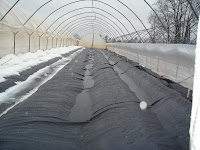
Tunnel 4 at the Piedmont Research Station, Salisbury, NC on Friday, February 5th.
We have been assessing the overwintering ability of predatory mites in high tunnel strawberry plots for the last 2 winters with the goal of optimizing organic management recommendations. There is a local and wholesale market for high quality winter strawberries, and several growers have begun to take advantage of this. Among theses grower is Sonny Cottle, in Faison, NC, who has produced organic strawberries in high tunnels for several years and has experimented with predatory mites and other organic twospotted spider mite management methods.
There are a lot of benefits to working in tunnels. We never have to worry about getting rained out from a miticide treatment (or a harvest), it's usually a balmy 50 degrees in the winter, and, not the least, the Piedmont Research Station personnel are top notch. However, this year has provided a primer in the challenges of tunnel production.
The differences between seasons were apparent immediately. TSSM reached threshold in the 2009 season in mid November (2008), and predators were released soon after. Our 2010 tunnel was adjacent to caneberry plots, and the spider mites migrated into our strawberries right after transplant. Our first predator release in 2010 season was in mid October (2009), and was less successful in suppressing an already large TSSM population. A second release was conducted in November (2009) which provided greater suppression.
The winter of 2009 was excellent for tunnel production--cool, but moderate temperatures, and only one snow storm to content with. We had one significant cold event in January which required irrigated frost protection, but row cover was sufficient for the remainder of the season. In 2010, we have experienced one the coldest winters in recent memory. Row covers have been in place almost every day for the last 2 months, which, unfortunately, has lead to extensive predatory mite movement between plots. We can still gather data on our primary objective, determining the ability of predatory mites to overwinter and reproduce in tunnels, but our release plots are no longer contained.
Our latest challenge has been snow. Although it was nothing compared to the recent storms in Washington, D.C., North Carolina had its share of snow the last weekend in January 2010. The 5 inch accumulation was enough to warrant the removal of our tunnel's (Tunnel 4) plastic skin to prevent collapse. As of today, our plants are covered with black plastic and row cover, and the tunnel is uncovered. Plans are to get the plastic back up today (Tuesday, February 9th), and we intend to sample Thursday to see what the impacts on TSSM and our predators are.
There's never a dull moment in agriculture--even in the "off" season!
No comments:
Post a Comment